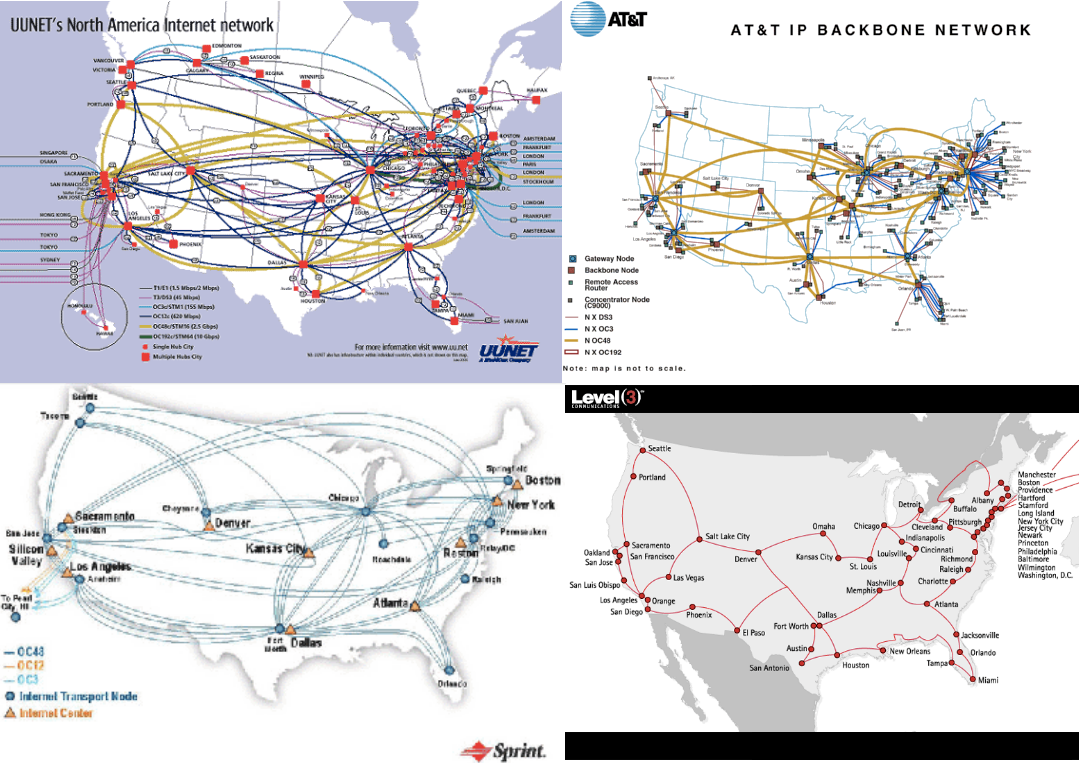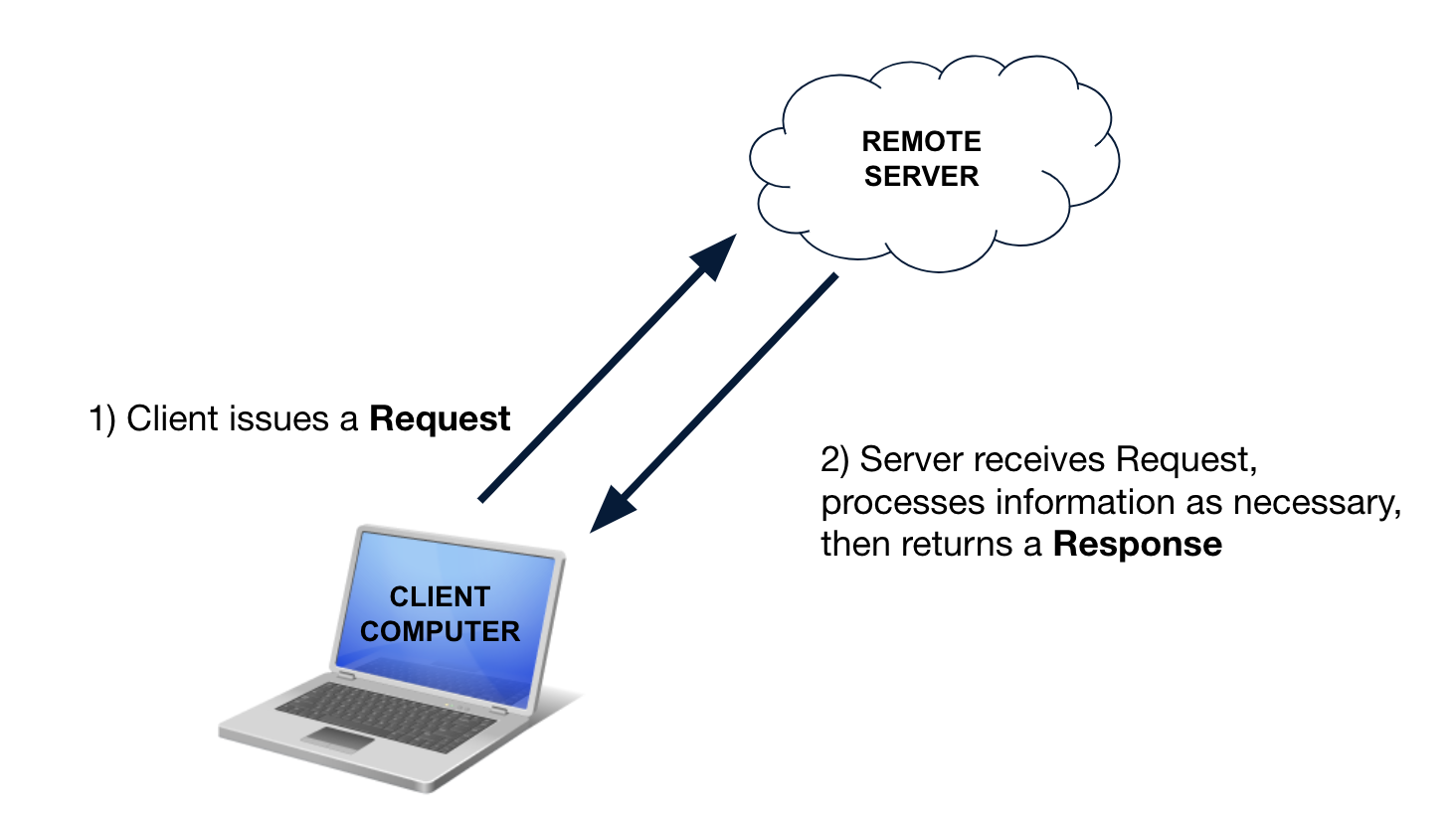26 Computer Networks Overview
Before we go fetching some data from the Internet, let’s take a moment to talk about how the Internet works. The Internet is an example of a computer network, a system of interconnected computers which use communications media to transmit data from one device to another.

26.1 Communications Media
This data is transmitted through either wired or wireless media. An example of a wired connection would be an Ethernet cable. An example of a wireless connection would be using WiFi.
Communications media refer to the pathways, or methods, by which data are transmitted. Cable media transmit information over physical wires or cables, whereas broadcast media (e.g. Bluetooth, WiFi, Cellular radio, Satellite radio) transmit information through electromagnetic waves.
26.2 Network Sizes
We can characterize networks by their size.
The smallest network is called a Personal Area Network (PAN), which connects devices, usually within the same room. For example, when you have your phone in your pocket, walking throughout the city, listening to your Bluetooth headphones, that network moves with you.
As the network size continues to increase, we might call it a Local Area Network (LAN), which connects devices, usually within the same building. For example, your home WiFi network connecting many rooms in your home.
As the network size continues to grow, we might call it a Wide Area Network (WAN), which covers a large geographical region. For example, a university network spanning many buildings on campus.
26.3 The Internet
The largest computer network is known as the Internet, which connects devices across the globe and in space.

26.4 Internet Protocols
Computers connected to the Internet communicate according to a common set of rules and procedures, or protocols. Each protocol is used for a specific purpose. Here are some of the most important Internet protocols:
| Abbreviation | Name | Description |
|---|---|---|
| HTTP | Hyper Text Transfer Protocol | The foundation protocol for the Internet. |
| HTTPS | Secure Hyper Text Transfer Protocol | A widely-used Internet protocol for secure network communication over HTTP within a connection encrypted by SSL/TLS. |
| SSL/TLS | Transport Layer Security (formerly and still known as Secure Sockets Layer) | For providing communication security over a network. |
| TCP/IP | Transmission Control Protocol (which compliments the Internet Protocol) | Provides reliable, ordered, and error-checked delivery of a stream of octets between applications running on hosts communicating over an IP network. |
| FTP | File Transfer Protocol | For transmitting large files between computers. |
| SMTP | Simple Mail Transfer Protocol | For transmitting electronic mail between computers. |
| SSH | Secure Shell | A cryptographic (encrypted) network protocol to allow remote login and other network services to operate securely over an unsecured network. |
| SFTP | Secure File Transfer Protocol | For transferring files over SSH. |
You may be already familiar with the Hyper Text Transfer Protocol (HTTP) and it’s secure version, HTTPS, when you view pages in the browser. But there’s other protocols as well. For example, SMTP for sending email, or SSH for logging into a remote server.
The Internet Protocol primarily governs the routing and delivery of information from one computer to another. Computers participating in these connections each have an address, or location where the information is sent and received. Just as a street address identifies a building within a connected system of roads and highways, and as a telephone number identifies a phone’s connection to a cellular network, an Internet Protocol (IP) address identifies a computer’s connection to the Internet. IP Address notation typically includes numbers separated by decimals in IP Version 4 (e.g. 144.228.10.74), and numbers or letters separated by colons in IP Version 6 (e.g. 2601:37b:c211:7109:7833:f6d1:1f15:9174).
When information is traveling throughout the network, data is separated into component parts and encapsulated into packets which also contain routing information. These packets may or may not take the same route across the network and may or may not arrive at the destination at the same time. Once all the packets are received, they are re-assembled into the original information representation.
26.5 HTTP
The protocol that we’re going to focus on is HTTP. HTTP is comprised of a two step process:
- The first step, one computer creates a request for some information, and sends that request to another computer.
- In the second step, The second computer fulfills the request and returns a response.

We can characterize the role of each computer in this process as client versus server, whereby the client computer is responsible for making the request, and the server is responsible for returning a response if it knows how. This is otherwise known as the client-server model.

For more information about HTTP, consult the following reference documentation:
26.5.1 HTTP Requests
In HTTP, there are certain types of requests that we can make, each for its own purpose. These are called request methods.
| Request Method | Purpose |
|---|---|
| GET | Request to receive some information from the server. |
| POST | Request to create some information on the server. |
| PUT/PATCH | Request to update some information on the server. |
| DELETE | Request to remove some information from the server. |
A GET request is used to ask for some information from the server. Like “Hey, could we get that data?”. Whereas a POST request will allow us to send some data to the server. For example, if we wanted to programmatically create a tweet, we would send that data to the Twitter API, for Twitter to store in their database. We use a PUT or PATCH request to ask to update some data, and a DELETE request to ask to delete data from the server.
When we fetch data from the Internet, the type of request that we’ll be using most often is the GET request.
26.5.2 HTTP Responses
In the same way that there are certain types of requests that the client can make, there are certain response codes that the server can reply with. Different response codes indicate different results relating to whether the request was successful or not.
| Response Code | Meaning |
|---|---|
| 100s | Information |
| 200s (e.g. 200, 202) | Successful |
| 300s (e.g. 301) | Redirect |
| 400s (e.g. 401, 403, 404) | Client Error |
| 500s | Server Error |
Generally, response codes in the 200s mean our request was successful, and the server was able to return some response. Response codes in the 400s mean that it was a client error. We made some mistake. We made the wrong request. Maybe we tried to request a page that doesn’t exist. You may be familiar with the 404 error.

We will see how these concepts regarding HTTP requests and responses translate into the techniques that we’ll use to request data over the Internet in Python.
